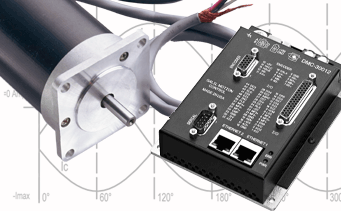A common shortcut with single axis controller/drive combinations is to use a single control loop (and processor) to handle both the Position Control Loop (ie: PID loop) and the Amplifier Current loop. Galil separates these two loops onto different hardware and therefore optimizes each of them for the highest system performance. For instance, on the DMC-30012 and -D3540 sinusoidal amplifiers, the current loop is closed at a 33kHz sample rate that gives a fast response and tight control of the current going to the motor. It allows a high closed loop frequency response of 3-4kHz. This frees the controller processor for closing the position loop as well as running programs and processing commands. This two-loop architecture allows Galil to be extremely responsive and highly accurate on many different types of servo systems.
Software Adjustable Settings to Interface to Many Different Servo Systems
Galil is able to achieve precise control over many different types of servo motors - (both brush and brushless) by allowing software-selectable control loop parameters (ie: PID) and amplifier current loop parameters. For instance, the gain of the amplifier is selectable using the AG command. This can be set for small, medium, or large motors and determines how much current is delivered to the motor. In addition, the controller's AU command allows the user to adjust the current loop gain high or low. A high current loop gain is good for motors with large inductance values. On rare occasions, a very specific current loop setting is needed. Galil offers the capability of further customizing the controller/amplifier settings at the factory in order to precisely match a user's servo system.
Sinusoidal Commutation for Smooth Motion
For the smoothest mechanical output of a brushless servo motor (linear and rotary), sinusoidal commutation is the best method for minimizing torque ripple. On standard trapezoidal-based commutation, a small amount of torque ripple occurs when switching from one phase to the next. On some servo motor systems, this torque ripple affects the smoothness of motion and may have an audible component such as a "ticking" sound when transitioning between phases. Sinusoidal commutation comes standard on the DMC-30012 single axis controller and drive and is available as the -D3540 amplifier on multi-axis systems.
Easy Setup and Integration
Several methods are available to commutate a brushless motor with the Galil sinusoidal drives. A short initialization procedure on power-up uses minimal motion and allows the controller to commutate a brushless motor using only the encoder feedback. This eliminates the need for Hall sensors. Removing the Hall sensors helps reduce cost and space of a motor while also making wiring and system setup easier. For systems where gravity or a constant force is present, Hall sensors may be required for proper commutation. On these systems, the controller can use them to initialize by simply moving past the first Hall transition. For further information on single or multi-axis controller and drive solutions, contact a Galil applications engineer.


